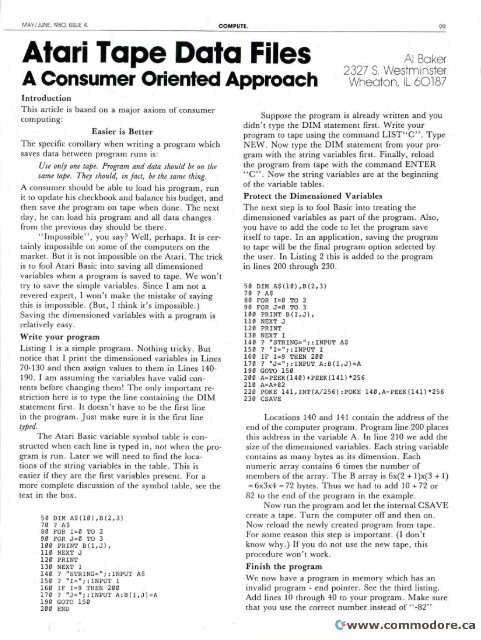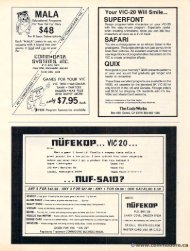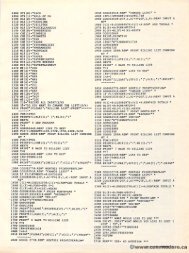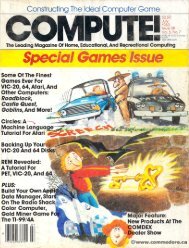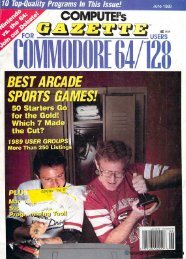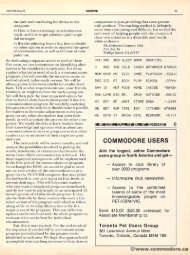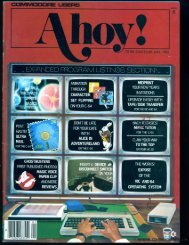May June 1980 - Commodore Computers
May June 1980 - Commodore Computers
May June 1980 - Commodore Computers
Create successful ePaper yourself
Turn your PDF publications into a flip-book with our unique Google optimized e-Paper software.
MAY/JUNE. I <strong>1980</strong> I960. . ISSUE 4. 4 COMPUTE. 9Q<br />
Atari Tape Data Files<br />
Atari Tape Data Files<br />
A Consumer Oriented Approach<br />
Introduction<br />
This article is based on a major axiom of consumer<br />
computing:<br />
Easier is Better<br />
The specific coroll ary when writing a program which<br />
The specific corollary when writing a program which<br />
saves data between program runs is:<br />
Use only one tape. Program and data should be on the<br />
same tape. They should, in fact, be the same thing.<br />
A consumer should be able to load his program, run<br />
it 10 to update hiss checkbook and balance hiss budget, and<br />
then save the program on tape when done. The next<br />
day, he can load his program and all data changes<br />
from the previous day should be there.<br />
" Impossible", you say? Well , perhaps. It is cer<br />
"Impossible", you say? Well, perhaps. It is cer<br />
tainly y impossible on some of the computers on the<br />
market. But it is not impossible on the Alari. Atari. The trick<br />
is to fool Atari Basic into saving all dimensioned<br />
variables when a program is saved to tape. We won't<br />
try 10 save the simple variables. Since I am not a<br />
try to save the simple variables. Since I am not a<br />
revered expert, I won't make the mistake of saying<br />
this is impossible. (But, I think it's impossible.)<br />
this is impossible. (But, I think it's impossible.)<br />
Saving the dimensioned variables with a program is<br />
relatively easy.<br />
Write your program<br />
Listing 1 is a simple program. Nothing tricky. But<br />
Listing 1 is a simple program. Nothing tricky. But<br />
notice that I print the dimensioned variables in Lines<br />
70-130 and then assign values to them in Lines 140-<br />
190. I am assuming the variables have valid contents<br />
before changing them! The only important restriction<br />
here is to type the line containing the DIM<br />
statement firsl. It doesn't have to be the first line<br />
statement first. It doesn't have to be the first line<br />
in the program. Just make sure it is the first line<br />
typed.<br />
The Atari Basic variable sy mbol table is con<br />
The Atari Basic variable symbol table is con<br />
structed when each line is typed in, , not when the program<br />
is run. Later we will need to find the locations<br />
of the string variables in the table . This is<br />
tions of the string variables in the table. This is<br />
easier if they are the first variables present. For a<br />
more complete discussion of the symbol table, see the<br />
text in the box.<br />
text in the box.<br />
50 DIM A$(10),B(2 , 3)<br />
50 DIM A?(10),B(2,3)<br />
70 ? A$ AS<br />
80 FOR 1=0 TO 2<br />
80 FOR 1=0 TO 2<br />
90 FOR J =0 TO 3<br />
90 FOR J = 0 TO 3<br />
1100 PRINT B{I,J), B( 110 NEXT J<br />
120 PRINT<br />
130 NEXT I<br />
14~ ? "STRING=";:INPUT A$<br />
140 ? "STRING=";:INPUT AS<br />
150 15~ ? "I=";:INPUT I<br />
160 IF 1=9 THEN 200<br />
160 IF 1=9 THEN 200<br />
170 17~ ? "J=";:INPUT "; : I A:B(I,J)=A<br />
, 190 GOTO 150<br />
190 GOTO 150<br />
200 END<br />
50 DIM A$(10),B(2,3)<br />
70 ? A$<br />
110 NEXT J<br />
1120 PRINT<br />
130 NEXT I<br />
140 14~ ? "STRING=";:INPUT ";: INPUT AS A$<br />
1501 5~ ? "I=";:INPUT I<br />
160 IF 1=9 THEN 200<br />
Al Baker<br />
2327 S S. Westminster<br />
Wheaton, IL 6O187<br />
210 A=A+82<br />
220 POKE 141,INT(A/256):POKE , 140,A-PEEK(141)*256141 230 CSAVE<br />
procedure won't work.<br />
AI Baker<br />
Wheaton, IL 60187<br />
Suppose the program is already written and you<br />
didn't type the DIM statement first. Write your<br />
program 10 to tape using the command LIST"C". Type<br />
NEW. Now type the DIM statement from your program<br />
with the string variables first. Finally, reload<br />
the program from tape with the command ENTER<br />
"e". "C". Now the string variables are at the beginning<br />
of the variable tables.<br />
Protect the Dimensioned Variables<br />
The next step is to fool Basic into treating the<br />
dimensioned variables as part of the program. Also,<br />
you have to add the code to let the program save<br />
itself to tape. In an application, saving the program<br />
to tape will be the final program option selected by<br />
the user. In Listing 2 this is added to the program<br />
in lines 200 through 230.<br />
50 Dnt A$( 1 0) ,B (2 ,3)<br />
80 FOR 1=0 TO 2<br />
90 FOR J=0 TO 3<br />
100 l~ ~ PRINT B(I,J),<br />
110 NEXT J<br />
130 NEXT I<br />
1 60 IF 1=9 THEN 200<br />
170 ? "J=" "J=";:INPUT ; :INPUT A: A:B(I,J)=A B(I , J)=A<br />
190 GOTO 150<br />
200 A=PEEK(140)+PEEK(141)*256<br />
)*256<br />
210 A=A+82<br />
230 CSAVE<br />
Locations 140 and 141 contain the address of the<br />
end of the computer program. Program line 200 places<br />
this address in the variable A. In line 210 we add the<br />
size of the dimensioned variables. Each string variable<br />
containss as many bytes as its dimension. Each<br />
numeric array contains 6 times the number of<br />
members of the array. The B array is 6x(2 + l)x(3 + 1)<br />
= ~ 6x3x4 = ~ 72 bytes. Thus we had to add 10 + 72 or<br />
82 to the end of the program in the example.<br />
Now run the program and let the internal CSAVE<br />
create a tape. Turn the computer off and then on.<br />
Now reload the newly created program from tape.<br />
For some reason this step is important. (I don't 't<br />
know why.) If you do not use the new tape, this<br />
procedure won't work.<br />
Finish the program<br />
We now have a program in memory which has an<br />
invalid program - end pointer. See Sec the third listing.<br />
Add lines 10 through 40 to your program. Make sure<br />
that you use the correct number instead of 4' -82"<br />
that you use the correct number instead of "-82"


